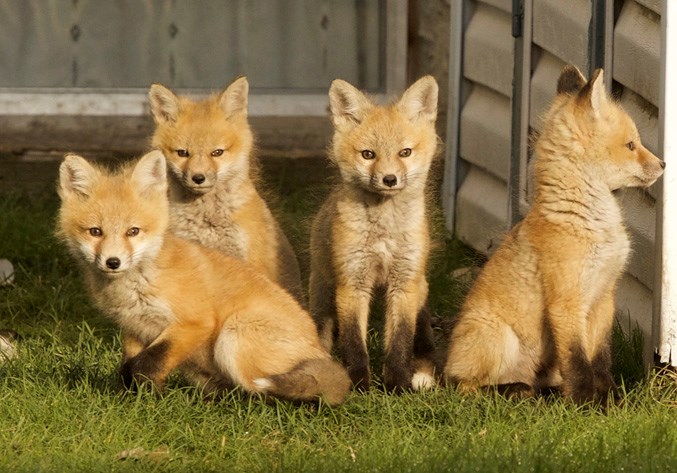One Okotoks family just grew by seven members overnight, as a family of foxes have moved in to their very own secondary suite under the garden shed.
Nicole Dawn said the family of five babies, called kits, and their parents have made a den in her backyard, but have posed no issue for the family.
“They only come out after 8 p.m. when no one is walking by anymore,” she said.
Classified as small carnivores, red foxes may look big, but the average adult red fox weighs only 15 pounds underneath their plentiful fur, making them about the size of a house cat, according to the National Wildlife Federation.
“It is something that we are starting to see a little bit more as humans are pushing out into what were more natural areas, of course the wildlife has to go somewhere,” said Katrina Jensen, education co-ordinator with the Alberta Institute for Wildlife Conservation. “Unfortunately they are deciding that people’s backyards are kind of attractive places.”
As unfortunate as this territory dispute may be, Jensen said that humans don’t need to worry about foxes.
“They’re very skittish around people and will do almost anything to avoid you if you’re outside,” she said.
Her only caution for people is if they have cats they are letting outside on a regular basis, as foxes could see them as a potential source of food.
“If you do have a cat and you’re letting your cat go outside, I would really caution you against that,” she said. “Not just for the cat’s benefit, but because cats are the number one killer of birds in Canada.
“Keeping cats indoors in general is just a good idea, but especially if you know there are foxes and coyotes in the area it’s much safer for the cat to be indoors or on a leash as well.”
Foxes natural diets typically consist of mice, voles, squirrels, rabbits, birds, and even grasses and vegetation. Alberta Fish and Wildlife also suggests keeping cats indoors and small dogs on leash.
While the foxes pose little risk on their own, Jensen said the same rules apply to any wildlife and cautions strongly against touching or feeding them.
She specifically said that she would not encourage small children to play outside near the foxes, if they try to pet the foxes or kits they could get bitten.
“If you child happens to grab one they’re going to try and defend themselves because to them we’re scary,” said Jensen.
Beyond that, she said there was "no realistic risk to people," and in fact there could be significant benefit as they will eat any mice in the area and help keep the rabbit populations under control.
“(Feeding them) is about one of the worst things we can do for foxes,” she said. “The more habituated they become the greater the risk to people and their pets. Definitely I would strongly discourage people from feeding them. The more they are around humans the more problems tend to occur with foxes (as they lose their fear of humans).
“We want to make sure they are not getting habituated, and they are perfectly capable of finding their own food, it is not a problem at all.”
Fish and Wildlife suggests removing as many food sources as possible from backyards, such as loose garbage, and tightly sealing containers that hold compost or garbage in order to limit their food source near humans.
Jensen said that once foxes have moved into an area it is difficult to get them to move along, and advises against trapping and relocating them.
“It often ends up with the babies being separated from the parents, and then the babies being orphaned by that,” she said. “We also see if foxes have been forcefully removed from an area, another fox family will probably move in.”
Foxes den during the summer months until the kits reach adolescence, which means the situation is temporary and not a long-term concern according to the National Wildlife Foundation.
There are humane deterrents people can try if foxes or other wildlife are causing problems, said Jensen, and suggested they call the Alberta Institute for Wildlife Conservation at 403-946-2361 for information.




